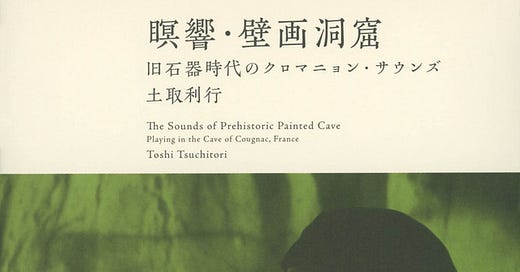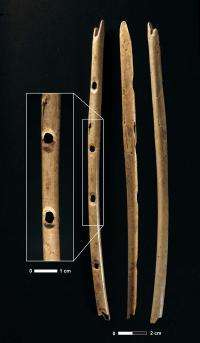Genre of the Day - Prehistoric Music
Album of the Day - The Sounds of Prehistoric Painted Cave: Playing in the Cave of Cougnac, France by Toshiyuki Tsuchitori (2008)
Much of the music I cover dates from prior to me and my readers’ lifetimes, and there was a streak of ancient phenomena on this column recently, but we’re taking it back just a wee bit further today. Today, we walk in the shoes—or lack thereof—of our hominid ancestors, wandering into the caves to marvel at the birth of rhythm. I’m celebrating another revolution around the sun tomorrow, so I too have been contemplating my own prehistory in a sense, trying to grasp the scope of my twenty years and appreciating all that I have experienced. To understand the complexities of the present, it’s important to understand what ties us to our ancient ancestors and our past individual selves; the two phenomena interlink for me today.
I had ample free time today and, with the wonders of Spotify, probably streamed over a hundred different songs, each possessing its own web of human tales. I somewhat aimlessly revisited the past by swiping through the thousands of photos in my camera roll. To be musically confronted by a time when stone tools were our greatest achievement made me suddenly grasp how overwhelming, albeit stimulating, it is to have so much information immediately available to me. Today’s primordial music is a chance to contemplate how existence felt when not a single activity I do on a daily basis or object in my surroundings existed, before this postmodern hyperreality and the literacy that allows randoms like me to write hyperfixated Substacks.
Certain French Enlightenement thinkers like Rousseau hypothesized that human language was derived from music, and that at one prehistoric point, the two were indistinguishable. We have no way of confirming, and scholarly inquiry has generated a range of interpretations; the field of biomusicology studies how human capacities produce musicality, taking into consideration parallels in nature, and archaeology has unearthed our earliest tools of musical assistance. Studying biomusicology can reveal insights in the universality of music accompanying a range of events across cultures, in studying human linguistic evolution, in symbol creation, and migration histories.
It also raises the question of what defines music: how different is it from animal song, and from human speech as in a tonal language and even in non-tonal languages’ indications of meaning through pitches? To distill the conclusion of 500 pages of research in the excellent compilation The Origins of Music is an impossible task under my constraints, so it may be better to shelve these fascinating but uncertain discourses on the voice and the language-music intersection for a look at the tangible early relics of musical expression. In 2008, archaeologists discovered a 40,000 year-old flute fashioned from a vulture bone in a German cave, and some drew a shocking conclusion that music’s capacity to create tighter social bonds was one component giving humans the upper hand over neanderthals. By about 10,000 years ago, there’s evidence of bone flutes in use across the world, the amount of holes in each forming the basis for scales and modes. We probably first applied rhythm to our music by the Stone Age, when tools striking together produced resonant sounds. Across the world, several groups employed bullroarers, a plank of wood attached to a rope that produces an astonishingly loud low-frequency humming that can travel miles.
Japanese musician and musicologist Tsuchitori Toshiyuki began his career in free jazz, a genre that prioritizes the undoing of rules; Toshiyuki goes one step further by investigating a time before governing musical rules. On today’s album, he imagines the sounds and rituals of ancient humans in the painted caves of France. In today’s soundscapes, we’re still thousands of years out from a music studio, let alone enclosed spaces that aren’t caves. The song names are rather New Age-inclined, but better that than some Proto-Indo-European reconstruction—“The Sea of Life” opens, echoey, repeated and ritualized, simple yet eternal melodic riffs. Piercing flutes fill the entire cave with pure energy on “Flying Megaloceros,” spurring us to imagine the stunning gravity of early instruments—the sonic worlds we access beyond our own voices by triggering physical phenomena seem to exist on a different plane, ephemeral yet imprinting upon our spirit. The dense, wild intensity of the shakers and drumming on later tracks may sound a bit ominous to our ears now, but these reconstructions could’ve represented stability and safety amidst an uncertain reality for our weary, migrating ancestors, helping them interpret their surroundings and alleviate fear amidst gathering as social beings. It helps us appreciate the scope of the thousands of years of creativity and development since, and our boundless human capacity to define the undefinable through music; as a human myself, entering a new era that somehow feels comfortingly less like an affront after today’s genre yet still significant as a facet of human existence, I intend to carry that tenet with me.






Cool article--I still have to find time to listen to the album. Meanwhile, somewhere between paleolithic and Renaissance lies the Bronze age. Still hoping you'll find a genre that encompasses groups like Heliung, Wardruna and Skáld. Looking forward to more...